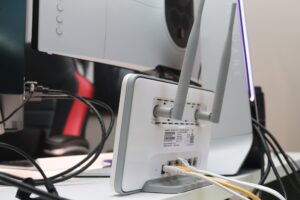
Non-WiFi Interference is Harming Your WiFi Network

It might sound crazy, but it’s true: non-WiFi devices can affect the performance of your WiFi network. How? Well, the wireless frequency bands (2.4GHz and 5GHz for businesses) are license-free. This means that any device can operate on them, sending signals back and forth through the same airspace as all your business critical WiFi devices. The signals can, in a sense, get in each other’s way, causing adverse effects on your network’s performance.
These effects are numerous and include:
- Loss of throughput
- Poor connectivity
- Lower data rate usage by WiFi devices
As none of this is good for business, it’s important to be aware of non-WiFi interference so that, when it strikes, it can quickly be resolved.
Sources of Interference
These can include:
- Bluetooth devices
- Microwaves
- Motion sensors that use infrared and radar
- Cordless phones
- Wireless video cameras
- Wireless headsets
- Fluorescent lights
- Poor electrical connections
In addition to devices that transmit signals, building materials like concrete and metal can also hamper a network’s performance, as can large aquariums or other sources of water.
Detection
Before any WiFi network issue can be resolved, it must first be detected and the root cause identified. Detection typically isn’t a problem – people aren’t going to keep quiet when the network isn’t providing optimal service. Root cause identification is a little more complicated though.
The issues mentioned above, like poor connectivity, could be caused by non-WiFi interference, but they could also be caused by WiFi interference, mismatched capabilities between APs and devices, or a number of other factors. Diagnosing the root cause therefore requires more information, otherwise businesses risk implementing a strategy that won’t effectively resolve the problem.
The only way to truly identify the actual culprit of poor network performance is with complete visibility into the RF environment. This environment is where transmissions on the wireless frequencies occur, and so it’s in this environment that the issue can be first spotted and identified. This requires IT teams to be able to monitor the entire environment rather than simply having visibility into their network and connected WiFi devices. One way to achieve this visibility is with a WiFi Automation platform like the Wireless Intelligence Platform (WIP).
Complete Visibility
WIP monitors the entire RF ecosystem 24/7. It learns to recognize normal network behavior and automatically alerts IT to any changes in that behavior. Alerts include the identified root cause and actionable suggestions for resolution.
Because many issues are intermittent, sometimes identification can require teams to spend days, or longer, manually monitoring the network in order to capture the right packets at the right time. Not only is this incredibly time consuming, it often isn’t feasible. IT teams can’t spend 24/7 at work, standing in one location, capturing data packets. Even more challenging, if teams don’t have a way to capture non-WiFi interference, the entire experience becomes useless and frustrating.
By monitoring the RF ecosystem for IT, and automatically and proactively identifying issues, WIP saves teams time and businesses money by safeguarding business productivity and operational efficiency.
Resolution
After detection and identification comes resolution. In an ideal world, WiFi networks would never have issues, but with networks growing more complex every day, minimizing issues and resolving them swiftly is the best available route for optimization. WIP decreases the Mean-Time-to-Resolution by 90% and reduces WiFi problem tickets by 60%, improving end user’s experience.
The platform also automatically stores historical device forensics. It creates graphs that display trends over time with data on APs, client distribution, RF and client utilization, noise level, and non-WiFi interference. This visible display of historical network performance and health provides businesses with valuable analytics for improved real-time and long-term network planning.
Get a Better Performing Network
The more you know, the more you can prepare. With more devices entering offices every day, the opportunity for network interference to strike down business productivity is only growing. Use WIP to monitor the entire RF ecosystem and identify all sources of interference, including that from non-WiFi devices, to remove the mystery from your WiFi network and experience reliable and consistent optimization.


